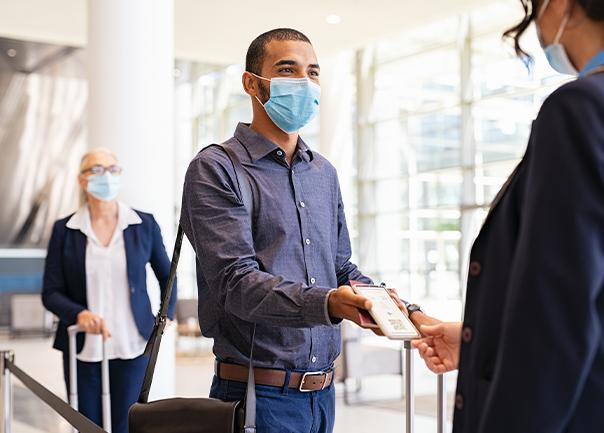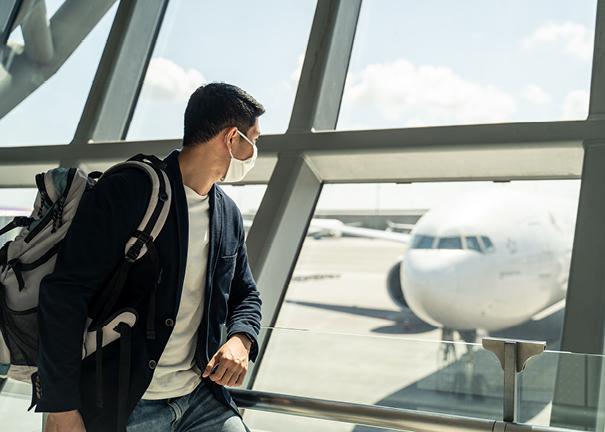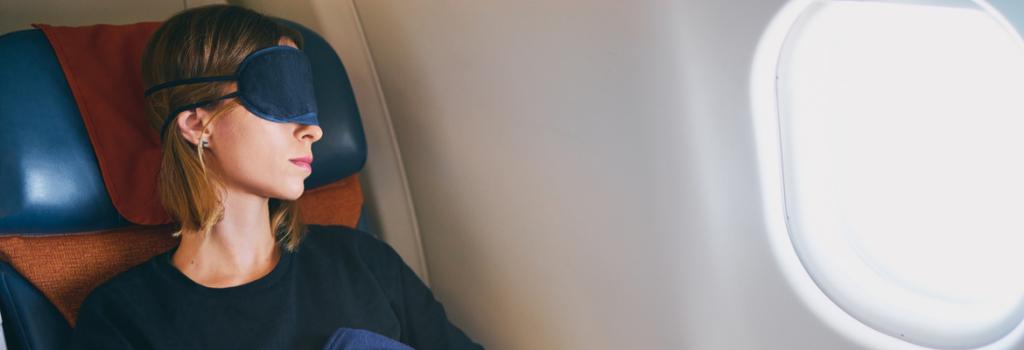
Jet lag - You know what we’re talking about. Those feelings of tiredness and exhaustion that are invariably accompanied by difficulty adjusting to the new day and night routine (also known as your natural circadian rhythms) because of travelling across different time zones. But what if you could minimise and reduce the effects of jet lag so it wasn’t so paralysing and you could arrive ready to do business?
Look no further! We’ve got quite a few hints and tips (think of it more like pre-training, race day and post-training) to help with easing the symptoms of jet lag. It starts with the lead up to your flight.
Before your flight

Here’s where the pre-training begins. You need to ensure that you are fully rested and adequately hydrated prior to your flight. An AFD (Alcohol Free Day) before your flight is well worth the health benefits you’ll enjoy and is a significant factor in minimising your jet lag.
“Coconut water is a great alternative for consuming within 24 hours of flying,” says Donna Abbate, Program Manager and Nutritionist/Naturopath at Gwinganna Lifestyle Retreat. “Coconut water is the Rolls Royce of water given it is packed full of electrolytes which are the minerals essential for keeping our cells hydrated.”
Fitting in some form of exercise before your trip if possible, will also be beneficial for your body as is getting yourself mentally prepared. Ensuring you’re in the right frame of mind for a long-haul flight (which by the way is considered anything longer than a six-hour flight) will help with the long hours of travelling ahead – you’ve got this!
Select an Aisle Seat in Centre of Plane
Choosing an aisle seat in the centre of the plane is a great start. It gives you that extra room to stretch during the flight, it means one less tray of food to be juggled over you and only one other travelling companion to worry about! The biggest drawcard is easy access to the bathroom - there’s nothing more annoying than having to excuse yourself to your co-passengers every time nature calls.
Travel in Stylish Comfort
While you might be tempted to don your “comfortable pants” for a long-haul trip, there’s still some expectation and decorum required when travelling for business. While comfort is important, choosing a smart casual option that includes a jacket or blazer is best. Who knows who you might bump into on your flight.
Get Your Electrolyte Fix
It’s well worth stocking up on Hydralyte’s. We all know how dehydrating travelling can be. In fact, the humidity in aircraft cabins is low, usually less than 20% (humidity in the home is normally over 30%).
So it’s important that when you get to your destination you’ve got the ability to rehydrate yourself. The quicker you can do this the faster your body will bounce back and you can hit the ground running. They’re also great to have on hand should you pick up any unwanted bugs during your travels.
Consider a Stopover
Many people include a stopover with their long-haul flights and for good reason. It’s a great way to break up the flight, it gives you time to reset and it’s another way to successfully combat jet lag. Adding a stopover to your trip isn’t hard and can often be done with little to no extra cost. Although, it’s always best to have your travel manager investigate the finer details for including any stopover with your next long-haul flight to ensure there’s no hidden costs or logistical surprises.
Prepare For Your New Time Zone
There are many apps to help you adjust to your new time zone and reduce jet lag symptoms however, none quite like TimeShifter. According to the rave reviews, this app has got everything covered and more, when it comes to travelling. It’s based on your sleep pattern, chronotype (in layman terms - a person’s natural sleep and awake time) and itinerary. The knowledge behind the app is backed by scientific research with many users finding extremely positive results with long-haul travel and jet lag.
Jetlag Rooster is another option. This app maintains that it help shift your body clock by also creating an individual plan using your trip details, bright light exposure and melatonin. There’s also research according to Jetlag Rooster that, shifting your body clock even before departing can sometimes reduce jet lag completely.
If you’d prefer not to use an app then Katina Karydas, QLD Assistant Team Leader at Healthwise also has another great suggestion. Katina says, “As soon as you board your flight, change your watch to the local time of your destination, and start eating and sleeping as if you were already there. This will give your body a head start in the adjustment process and make life easier once you arrive.”
Hint – Interestingly, there’s also scientific research to show that flying west-east over more than three time zones results in significant less ability to perform. The upshot - being aware of this and more vigilant with sticking to your plan may assist greatly with the reducing the effects of jet lag.
During your flight
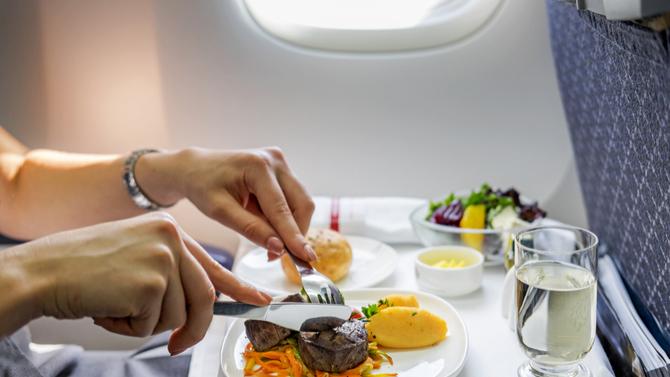
Race day. Now that you’ve done all the preparation leading up to your flight it’s very important that you follow through with the plan while travelling to minimise jet lag.
Pass on the Carbs
Aeroplane food hasn’t always had the best rap however, it has improved over the years with many airlines choosing to partner with well-known chefs, like Qantas and Neil Perry.
Better still, recently Chef Perry and Qantas took it one step further, with the help of metabolic scientists from the University of Sydney’s Charles Perkins Centre, and devised new jet lag defying menus for the airline’s long-haul 787 Dreamliner flight between Perth and London.
If you’re not lucky enough to be travelling on the Qantas Perth to London leg, then Dietitian Jodie Wilson from The Dietitian Studio offers some sage advice. “Aim to select a lighter meal that has a decent portion of quality protein such as lean meat, fish, chicken or eggs and includes some vegetables or salad. Avoiding heavy creamy pastas and curries is a safe bet. Always try to choose high protein and nutritious snacks mid meals such as yoghurt, fresh fruit and nuts rather than cakes, pastries and crisps.”
Jodie also echo’s the sentiment of many others when it comes to drinking alcohol and caffeinated drinks during long-haul flights. She says, “avoid caffeinated beverages such as coffee, black tea, colas and energy drinks. All of these not only contribute to dehydration, they can disturb your sleep as well. Similarly, alcoholic beverages can not only negatively influence hydration levels but they too affect normal sleeping patterns and are best avoided.”
Make sure you drink plenty of water during and immediately after the flight.
Sleep According to Your Destination
Getting some sleep on the plane is essential. It’s even better if you can begin to sleep in line with your new time zone.
Sleeping on planes however, doesn’t come naturally to many travellers. If this is the case for you then try some sleeping tools like neck pillows and noise cancelling earphones. Techradar have put together a great list showcasing the best noise cancelling earphones. Alternatively, there’s always the app myNoise. It comes complete with a fantastic range of background noises that you can tune out and sleep to (Consider Rain on a Tent or Waterfalls).
You can also try eating your way to sleep according to Jodie. “There are a number of foods that are thought to help foster sleep or at the very least contribute to a less disturbed one. Choose unrefined, low Glycaemic Index (GI) carbohydrates such as whole grains, dairy, legumes and fruits such as bananas or cherries or select nuts such as walnuts or almonds.”
Sipping on herbal teas like Chamomile, Peppermint or Ginger can also be calming and help initiate sleep.
Movement
Making sure you incorporate some element of stretching and movement during your flight is, “essential to limit jet lag”, says Donna. “This is because our lymphatic system (another garbage system of the body) does not have a pump which means we need to move for it to move. When the lymphatic fluid builds up we feel swollen, puffy and bloated. Gentle movement or dry skin brushing repairs this build up, so be sure to get up and move around, or stretch where possible.”
When travelling herself, Donna completes knee hugs, seated spinal twists, foot pumps, neck and shoulder rolls, even self-foot and leg massage every hour while flying.
“These seated exercises are easy to do and can make a huge difference to how you feel while flying. Every hour I also recommend getting up and doing a short walk where you can around the cabin, have a toilet break and while you are using the bathroom take some time to do a quick dry skin brushing massage for a few minutes. Use the brush with gentle strokes on your bare skin to help the circulation move around your body,” she says.
After your flight
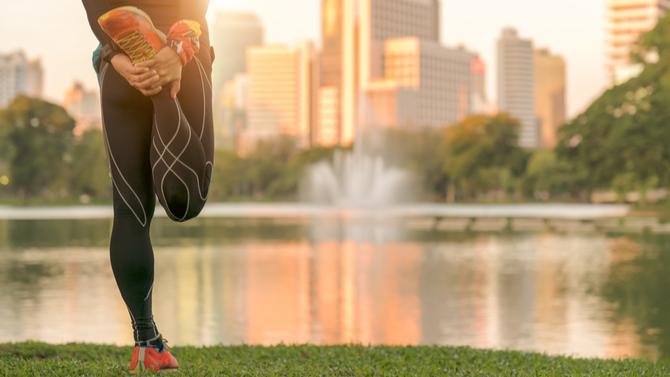
Post training – Don’t stop now! Once you arrive there are a couple of things you can do to help kick start your body into its new routine.
“If possible, once you reach your destination be sure to commit to a good 45-minute walk to help the lymphatic system drain, and flush away any toxins held within it,” recommends Donna.
“If you prefer not to walk you can also do a gentle yoga routine when you get back to your room from a laptop or try a no-weights workout in the hotel gym, swim in the pool or choose any type of movement that feels great for your body,” she explains.
There’s also a thing called Melatonin. Melatonin is a hormone produced in your body that helps to regulate sleep wake cycles. It can be found naturally occurring in some foods (like pineapples, oats and bananas) and is also available in supplement form which has been known to help as a short- term treatment for trouble sleeping from jet lag. The Sleep Health Foundation recommends the ideal time to take Melatonin is an hour before your planned sleep time.
Ready, set, go
Now that you’ve got your training schedule sorted it’s time to commit. As with any plan commitment is key. Hydration, movement, sleep and a positive mindset are vital to conquering the dreaded jet lag. If all are managed successfully you should breeze off your next long-haul flight, ready to tackle your first business meeting with a clear head and a spring in your step!

